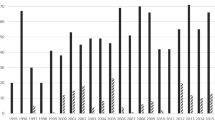Abstract
The Economic and Strategic Motives for Antidumping Filings. — This paper looks at worldwide antidumping activity during the last two decades. We examine the motives for AD filings by countries in an attempt to identify whether economic or strategic concerns are driving the recent upsurge in AD use. We begin by providing a comprehensive overview of the data on cases initiated in the 1980–1998 period. We then use nonparametric methods to identify motivations for the use of antidumping and find considerable support for strategic motivations. This suggests that the rise in AD activity cannot be solely explained by an increase in unfair trading practices.
Similar content being viewed by others
References
Bagwell, K., and R. Staiger (1990). A Theory of Managed Trade.American Economic Review 80 (4): 779–795.
Blonigen, B. A., and C. P. Bown (2001). Antidumping and Retaliation Threats. Mimeo. Brandeis University, October.
Boltuck, R., and R. E. Litan (eds.) (1991).Down in 45ethe Dumps: Administration of the Unfair Trade Laws. Washington, D.C.: Brookings Institute.
Brander, J. A., and P. Krugman (1983). A ‘Reciprocal Dumping’ Model of International Trade.Journal of International Economics 15 (3-4): 313–321.
Clarida, R. H. (1996). Dumping: In Theory, in Policy, and in Practice. In J. Bhagwati and R. Hudec (eds.),Fair Trade and Harmonization: Prerequisites for Free Trade? Cambridge: MIT Press.
Corden, W. M. (1974).Trade Policy and Economic Welfare. Oxford: Oxford University Press.
Dixit, A. K. (1987). Strategic Aspects of Trade Policy. In T. F. Bewley (ed.),Advances in Economic Theory: Fifth World Congress. New York: Cambridge University Press.
Ethier, W. J. (1982). Dumping.Journal of Political Economy 90 (3): 487–506.
Finger, J. M. (ed.) (1993).Antidumping. Ann Arbor, MI: University of Michigan Press.
Finger, J. M., and K. C. Fung (1994). Will GATT Enforcement Control Antidumping?Journal of Economic Integration 9 (2): 198–213.
Green, E. J., and R. H. Porter (1984). Noncooperative Collusion Under Imperfect Price Information.Econometrica 52 (1): 87–100.
Grossman, G., and E. Helpman (1994). Protection for Sale.American Economic Review 84 (4): 833–850.
Hansen, W. L., and T. J. Prusa (1996). Cumulation and ITC Decision Making: The Sum of the Parts is Greater than the Whole.Economic Inquiry 34 (4): 746–769.
Hansen, W. L., and T. J. Prusa (1997). The Economics and Politics of Trade Policy: An Empirical Analysis of ITC Decision Making.Review of International Economics 5 (2): 230–245.
Horlick, G. N. (1989). The United States Antidumping System. In J. H. Jackson and E. A. Vermulst (eds.),Antidumping Law and Practice: A Comparative Study. Ann Arbor, MI: University of Michigan Press.
Jensen, R., and M. Thursby (1984). Free Trade: Two Noncooperative Approaches. Ohio State University Working Paper.
Lindsey, B. (1999). The U.S. Antidumping Law Rhetoric versus Reality. Cato Institute Trade Policy Analysis Number 7. Washington, D.C.
Messerlin, P. (1989). The EC Antidumping Regulations: A First Economic Appraisal, 1980-85.Weltwirtschaftliches Archiv 125 (3): 563–587.
Miranda, J., R. A. Torres, and M. Ruiz (1998). The International Use of Antidumping: 1987-1997.Journal of World Trade 32 (5): 5–71.
Prusa, T. J. (2001). On the Spread and Impact of Antidumping.Canadian Journal of Economics 34 (3): 591–611.
Prusa, T. J., and S. Skeath (2002). Modern Commercial Policy: Managed Trade or Retaliation? Forthcoming inHandbook of International Trade and Law. Oxford: Basil Blackwell.
Riezman, R. (1982). Tariff Retaliation from a Strategic Viewpoint.Southern Economic Journal 48 (3): 583–593.
Santos, L. E. (ed.) (1998).The Compendium of Foreign Trade Remedy Laws. Washington, D.C.: The American Bar Association.
Tharakan, P. K. M., and J. Waelbroeck (1994a). Determinants of Anti-dumping and Countervailing Duty Decisions in the European Communities. In M. Dewatripont and V. Ginsburgh (eds.),European Economic Integration: A Challenge in a Changing World. Amsterdam: North-Holland.
Tharakan, P. K. M., and J. Waelbroeck (1994b). Antidumping and Countervailing Duty Decisions in the E.C. and in the US: An Experiment in Comparative Political Economy.European Economic Review 38 (1): 171–193.




